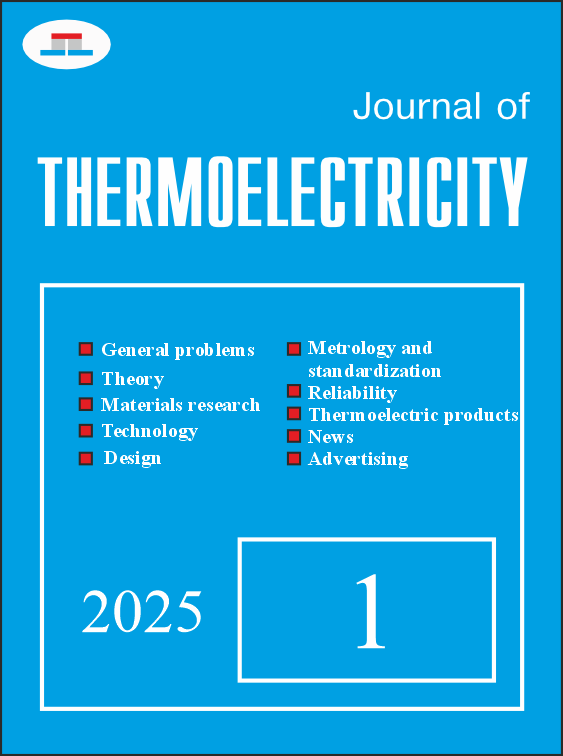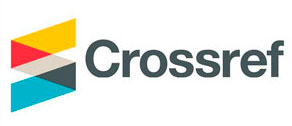Computer Optimization of the Working Tool For a Thermoelectric Cryodestruction Device
DOI:
https://doi.org/10.63527/1607-8829-2025-1-81-100Keywords:
thermoelectricity, thermoelectric device, working tool, computer optimization, computer simulation, cryodestruction, temperature impact, cooling mode, temperature distribution, biological tissue, oncological neoplasmAbstract
The paper presents the results of computer simulation of the temperature impact on biological tissue with an oncological neoplasm in the cooling mode. A physical, mathematical and computer model of biological tissue with an oncological neoplasm was constructed taking into account thermophysical processes, blood circulation, heat exchange, metabolic processes and phase transition. Computer optimization of the working tool and calculation of the heat removal system of thermoelectric modules for a thermoelectric cryodestruction device were carried out. Temperature distributions in biological tissue and the cooling working tool were determined. The results obtained make it possible to determine the freezing depth of biological tissue, in particular of oncological neoplasms, at a given temperature impact. A method of computer calculation of the temperature impact on biological tissues has been developed, which allows obtaining temperature distributions inside biological tissue and predicting the freezing depth during cryodestruction
References
1. Anatychuk, L. I. (1998). Thermoelectricity: Vol. 1. Physics of Thermoelectricity. Kyiv-Chernivtsi: Institute of Thermoelectricity.
2. Anatychuk, L. I. (2003). Thermoelectricity: Vol. 2. Thermoelectric power converters. Kyiv-Chernivtsi: Institute of Thermoelectricity.
3. Anatychuk, L. I., & Vikhor, L. N. (2012). Thermoelectricity: Vol. IV. Functionally graded thermoelectric materials. Kyiv-Chernivtsi: Institute of Thermoelectricity.
4. Vikhor, L., & Kotsur, M. (2023). Evaluation of efficiency for miniscale thermoelectric converter under the influence of electrical and thermal resistance of contacts. Energies, 16(10), 4082. https://doi.org/10.3390/en16104082
5. Anatychuk, L. I., & Lysko, V. V. (2020). Thermoelectricity: Vol. 5. Metrology of thermoelectric materials. Chernivtsi: Bukrek.
6. Anatychuk, L. I., & Lysko, V. V. (2012). Modified Harman's method. AIP Conference Proceedings, 1449, 373–376. https://doi.org/10.1063/1.4731495
7. Anatychuk, L. I., Havryliuk, M. V., & Lysko, V. V. (2015). Absolute method for measuring thermoelectric properties of materials. Materials Today: Proceedings, 2(2), 737–743. https://doi.org/10.1016/j.matpr.2015.07.299
8. Lysko, V. V., Razinkov, V. V., & Havryliuk, M. V. (2024). Equipment for determining the thermal conductivity of thermoelectric materials and the thermal resistance of contact structures using the absolute method. Journal of Thermoelectricity, 3, 53–63.
9. Nekhlopochin, O. S., Pilipenko, M. M., & Dubrov, S. O. (2023). Damage to major blood vessels during lumbar dissectomy: Risk factors, diagnostics, methods of surgical correction, features of anesthetic support and intensive care. Ukrainian Neurosurgical Journal, 29(3), 3–18.
10. Dobson, G. P. (2020). Trauma of major surgery: A global problem that is not going away. International Journal of Surgery, 81, 47–54. https://doi.org/10.1016/j.ijsu.2020.07.032
11. Kushneryk, L. Ya., Seniutovych, R. V., & Ivanskyi, A. E. (2003). Thermoelectric device for surgery of oncodiseases. Journal of Thermoelectricity, 2, 81–86.
12. Moskalyk, I. A., & Manyk, O. M. (2013). On the use of thermoelectric cooling in cryodestruction practice. Journal of Thermoelectricity, 6, 84–92.
13. Moskalyk, I. A. (2015). On the use of thermoelectric devices in cryosurgery. Physics and Chemistry of the Solid State, 4, 742–746.
14. Miller, P., & Metzner, D. (1969). Cryosurgery for tumors of the head and neck. Transactions of the American Ophthalmological and Otolaryngological Society, 73(2), 300–309.
15. D’Hont, G. (1974). La cryotherapie en ORL. Acta Otorhinolaryngologica Belgica, 28(2), 274–278.
16. Mazur, P. (1968). Physical-chemical factors underlying cell injury in cryosurgical freezing. In R. W. Rand, A. P. Rinfret, & H. Leden (Eds.), Cryosurgery (pp. 32–51). Springfield, IL: Charles C Thomas Publisher.
17. Hu, B., Shi, X.-L., Zou, J., & Chen, Z.-G. (2022). Thermoelectrics for medical applications: Progress, challenges, and perspectives. Chemical Engineering Journal, 437(Part 2), 135359. https://doi.org/10.1016/j.cej.2022.135359
18. Yang, S., Li, Y., Deng, L., Tian, S., Yao, Y., Yang, F., Feng, C., Dai, J., Wang, P., & Gao, M. (2023). Flexible thermoelectric generator and energy management electronics powered by body heat. Microsystems & Nanoengineering, 9, 106. https://doi.org/10.1038/s41378-023-00532-4
19. Bause, H. (2004). Kryotherapie lokalisierter klassischer, neues Verfahren mit Peltier-Elementen (–32 °C): Erfahrungsbericht Hamangiome. Monatsschrift für Kinderheilkunde, 152, 16–22.
20. Anatychuk, L. I., Ivaschuk, O. I., Kobylianskyi, R. R., Postevka, I. D., Bodiaka, V. Yu., & Gushul, I. Ya. (2016). Thermoelectric device for temperature and heat flux density measurement "ALTEC-10008". Journal of Thermoelectricity, 1, 74–81.
21. Anatychuk, L. I., Kobylianskyi, R. R., Konstantinovich, I. A., Lys’ko, V. V., Puhantseva, O. V., Rozver, Y. Yu., & Tiumentsev, V. A. (2016). Calibration bench for thermoelectric converters of heat flux. Journal of Thermoelectricity, 5, 65–72.
22. Anatychuk, L. I., Vikhor, L. M., Kobylianskyi, R. R., Kadeniuk, T. Y., & Zvarych, O. V. (2017). Computer simulation and optimization of the dynamic operating modes of thermoelectric reflexotherapy device. Journal of Thermoelectricity, 3, 65–74.
23. Anatychuk, L. I., Vikhor, L. M., Kobylianskyi, R. R., & Kadeniuk, T. Y. (2017). Computer simulation and optimization of the dynamic operating modes of thermoelectric device for treatment of skin diseases. Journal of Thermoelectricity, 2, 46–59.
24. Anatychuk, L. I., Pasechnikova, N. V., Naumenko, V. O., Zadorozhnyi, O. S., Danyliuk, S. L., Havryliuk, M. V., Tiumentsev, V. A., & Kobylianskyi, R. R. (2020). Thermoelectric device for contact cooling of the human eye. Physics and Chemistry of Solid State, 21(1), 140–145.
25. Anatychuk, L. I., Kobylianskyi, R. R., & Kadenyuk, T. Y. (2017). Computer simulation of local thermal effect on human skin. Journal of Thermoelectricity, 1, 62–70.
26. Anatychuk, L. I., Pasyechnikova, N. V., Naumenko, V. A., Kobylianskyi, R. R., & Gavrilyuk, N. V. (2019). A thermoelectric device for ophthalmic heat flux density measurements: Results of piloting in healthy individuals. Oftalmologicheskii Zhurnal, (3), 45–51.
27. Havryliuk, M. V., & Konstantynovych, І. A. (2014). Thermoelectric device for electrophoresis. Naukovy visnyk Chernivetskoho Universytetu. Fizyka. Elektronika – Scientific Bulletin of Chernivtsi University. Physics. Electronics, 3(1), 101–104.
28. Kobylianskyi, R. R., Kobylianska, A. K., & Fedoriv, R. V. (2024). Computer simulation of temperature distributions in the human heart during cryoablation. Journal of Thermoelectricity, (3), 23–35.
29. Kobylianskyi, R. R., Lysko, V. V., & Boychuk, V. V. (2024). Computer-aided design of thermoelectric microcalorimetric sensors. Journal of Thermoelectricity, (1–2), 97–112.
30. Kobylianskyi, R. R., Zadorozhnyi, O. S., Umanets, M. M., Pasyechnikova, N. V., Rozver, Y. Yu., & Babich, A. O. (2024). Computer simulation of a thermoelectric device for controlling the temperature of irrigation fluid during ophthalmological operations. Journal of Thermoelectricity, (1–2), 61–71.
31. Kobylianskyi, R., Przystupa, K., Lysko, V., Majewski, J., Vikhor, L., Boichuk, V., Zadorozhnyy, O., Kochan, O., Umanets, M., & Pasyechnikova, N. (2025). Thermoelectric measuring equipment for perioperative monitoring of temperature and heat flux density of the human eye in vitreoretinal surgery. Sensors, 25(4), Article 999. https://doi.org/10.3390/s25040999
32. Anatychuk, L. I., Kobylianskyi, R. R., & Fedoriv, R. V. (2022). Computer simulation of the working tool of a thermoelectric device for cryodestruction with account of the phase transition. Journal of Thermoelectricity, (3–4), 18–30.
33. Gill, W., & Fraser, I. (1968). A look at cryosurgery. Scottish Medical Journal, 13, 268–273.
34. Van Venrjy, G. (1975). Freeze-etching: Freezing velocity and crystal size at different size locations in samples. Cryobiology, 12(1), 46–61.
35. COMSOL AB. (2018). COMSOL Multiphysics User’s Guide (710 p.).
36. Pennes, H. H. (1948). Analysis of tissue and arterial blood temperatures in the resting forearm. Journal of Applied Physiology, 1(2), 93–122.
37. Lim, H. L., & Gunasekaran, V. (2011). Mathematical modeling of heat distribution during cryosurgery. https://isn.ucsd.edu/courses/beng221/problems/2011/project10.pdf
38. Myers, R. S., Hammond, W. G., & Ketcham, A. S. (1970). Cryosurgical necrosis of the head of the pancreas. Annals of Surgery, 171(3), 413–418.
39. Deng, Z. S., & Liu, J. (2005). Numerical simulation of selective freezing of target biological tissues following injection of solutions with specific thermal properties. Cryobiology, 50, 183–192.
40. Jiang, S. C., Ma, N., Li, H. J., & Zhang, X. X. (2002). Effects of thermal properties and geometrical dimensions on skin burn injuries. Burns, 28, 713–717.
41. Cetingul, M. P., & Herman, C. (2008). Identification of skin lesions from the transient thermal response using infrared imaging technique. IEEE, 1219–1222.
42. Ciesielski, M., Mochnacki, B., & Szopa, R. (2011). Numerical modeling of biological tissue heating. Admissible thermal dose. Scientific Research of the Institute of Mathematics and Computer Science, 1(10), 11–20.
43. Filipoiu, F., Bogdan, A. I., & Carstea, I. M. (2010). Computer-aided analysis of the heat transfers in skin tissue. In Proceedings of the 3rd WSEAS Int. Conference on Finite Differences - Finite Elements - Finite Volumes - Boundary Elements (pp. 53–59).
44. Carstea, D., Carstea, I., & Carstea, I. M. (2011). Interdisciplinarity in computer-aided analysis of thermal therapies. WSEAS Transactions on Systems and Control, 6(4), 115–124.
45. Shah, V. N., Orlov, O. I., Orlov, C., Takebe, M., Thomas, M., & Plestis, K. (2018). Combined cryo-maze procedure and mitral valve repair through a ministernotomy. Multimedia Manual of Cardiothoracic Surgery. https://doi.org/10.1510/mmcts.2018.022
46. Rykaczewski, K. (2019). Modeling thermal contact resistance at the finger-object interface. Temperature, 6(1), 85–95.
47. Beliayev, M. M. (1989). Fundamentals of heat transfer. Kyiv: Vyscha shkola.
48. ITE. http://ite.cv.ua




